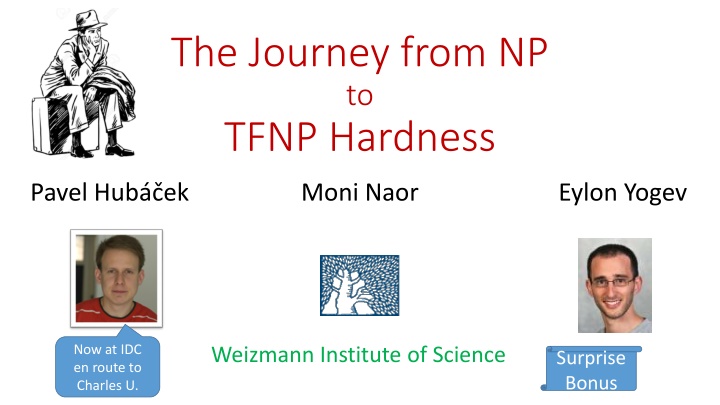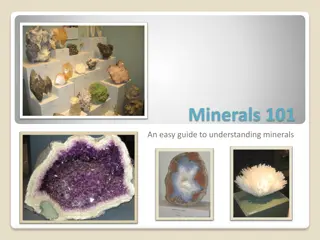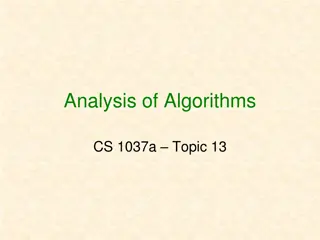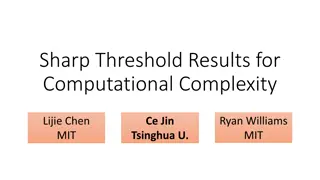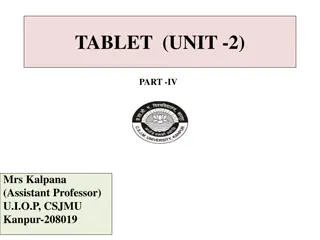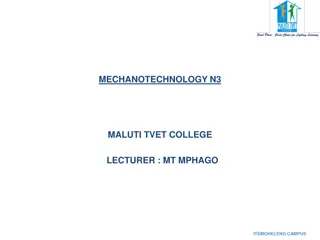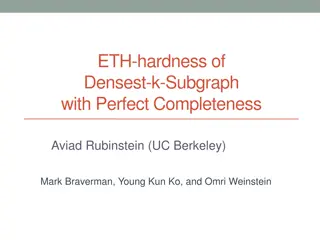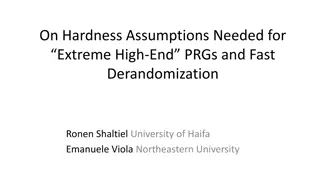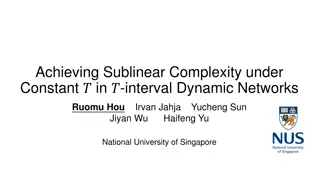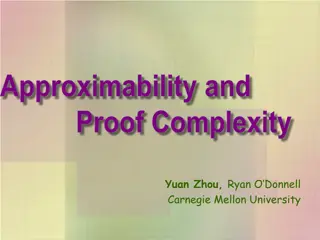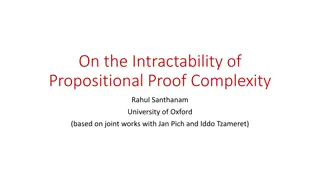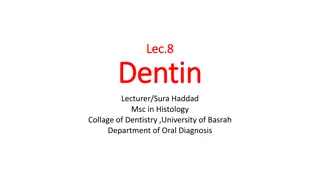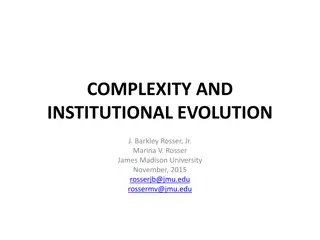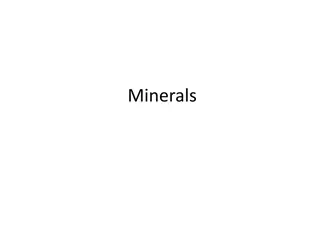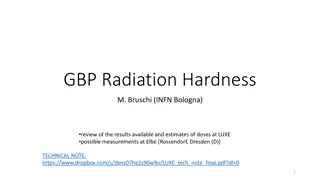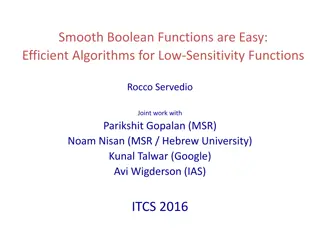Insights into TFNP Hardness and Complexity from Various Perspectives
Delve into the realm of TFNP hardness and complexity through discussions on the journey from NP to TFNP, TFNP total function NP, barriers for proving TFNP hardness, Impagliazzo's Five Worlds, and more. Explore the nuances of NP, coNP, P, and NP completeness while pondering the weakest assumptions underpinning TFNP hardness proofs.
Download Presentation

Please find below an Image/Link to download the presentation.
The content on the website is provided AS IS for your information and personal use only. It may not be sold, licensed, or shared on other websites without obtaining consent from the author.If you encounter any issues during the download, it is possible that the publisher has removed the file from their server.
You are allowed to download the files provided on this website for personal or commercial use, subject to the condition that they are used lawfully. All files are the property of their respective owners.
The content on the website is provided AS IS for your information and personal use only. It may not be sold, licensed, or shared on other websites without obtaining consent from the author.
E N D
Presentation Transcript
The Journey from NP to TFNP Hardness Pavel Hub ek Moni Naor Eylon Yogev Now at IDC en route to Charles U. Weizmann Institute of Science Surprise Bonus
I rarely end up where I was intending to go, but often I end up somewhere I needed to be. Douglas Adams
TFNP Total Function NP [MP91] NP: easy to verify decision problems FNP: easy to verify search problems Given an instance x, find a valid witness for x TFNP: a subclass of FNP with guaranteed solution Megiddo and Papadimitriou FNP coNP NP TFNP P FP
Complexity Zoo Complexity Zoo Polynomial Pigeonhole Principle [Pap94] ???? Local Optimum [JPY88] ??? ??? ???? Nash Equilibrium Brouwer Fixed Points [Pap94,DGP09, CDT09] ??? Continuous Local Optimum [DP11] Oracle separations
Hardness Hardness Collision resistant hash / one-way permutation [Pap94] ???? P NP ? ??? ??? ???? Obfuscation [BPR15, GPS16] End-of-line ??? Obfuscation [HY17]
WHAT IS THE WEAKEST ASSUMPTION UNDER WHICH WE CAN SHOW HARDNESS OF TFNP?
Barriers for Proving TFNP Hardness 1. TFNP hardness from worst-case NP hardness NP = coNP [JPY88,MP91]. 2. A randomized reduction from TFNP to NP SAT is checkable [MX10]. 3. There exists an oracle relative to TFNP is easy and PH is infinite [BFK+10]. 4. TFNP hardness from one-way functions exponentially many solutions [RSS16]. Rosen, Segev, Shahaf Mahmoody and Xiao Buhrman, Fortnow, Koucky, Rogers and Vereshchagin
The Five Worlds of Impagliazzo Cryptomania: public-key cryptography Minicrypt: one-way functions but public-key crypto Pessiland: NP is hard-on-average but one-way functions Heuristica: P NP but NP is easy-on-average Obfustopia: indistinguishability obfuscation Algorithmica: P = NP
The Five Worlds of Impagliazzo Cryptomania: public-key cryptography Minicrypt: one-way functions but public-key crypto Pessiland: NP is hard-on-average but one-way functions Heuristica: P NP but NP is easy-on-average Obfustopia: indistinguishability obfuscation Algorithmica: P = NP
The Five Worlds of Impagliazzo Cryptomania: public-key cryptography Minicrypt: one-way functions but public-key crypto Pessiland: NP is hard-on-average but one-way functions Heuristica: P NP but NP is easy-on-average Obfustopia: indistinguishability obfuscation Algorithmica: P = NP
Our Results Our Results TFNP hardness can be based on any hard-on-average language in NP For example: planted clique, random SAT, etc. In particular, any one-way function Our results show: hard-on-average TFNP problems exist in Pessiland (and beyond)
The Five Worlds of Impagliazzo Cryptomania: public-key cryptography Minicrypt: one-way functions but public-key crypto Pessiland: NP is hard-on-average but one-way functions Heuristica: P NP but NP is easy-on-average Obfustopia: indistinguishability obfuscation Algorithmica: P = NP
The Five Worlds of Impagliazzo TFNP Hardness Cryptomania: public-key cryptography Minicrypt: one-way functions but public-key crypto Pessiland: NP is hard-on-average but one-way functions Heuristica: P NP but NP is easy-on-average Obfustopia: indistinguishability obfuscation Algorithmica: P = NP
Proof Let ? ?? be a hard-on-average language with distribution D {0,1}n D L x Not in TFNP Search Problem: given x D find w such that (x,w) L
Reverse Randomization Let ? ?? be a hard-on-average language with distribution D Ls: ? ?? ? ? ? {0,1}n Ls D L x Search Problem: given x D find w such that (x,w) L OR (x,w) Ls
Reverse Randomization Let ? ?? be a hard-on-average language with distribution D Ls: ? ?? ? ? ? {0,1}n Ls D Not hard distribution L Distributed according to D x Random shift of D Search Problem: given x D find w such that (x,w) L OR (x s,w) L
Proof L : r L D(r) L D {0,1}m {0,1}n L L r x
Proof L : r L D(r) L {0,1}m r U Search Problem: given r U find w such that (D(r),w) L L r
Proof L : r L D(r) L For random ? define ? ?? {0,1}m r ? ? ? ? U Search Problem: given r U find w such that (D (r),w) L OR (D (r s),w) L L r L?
Proof L : r L D(r) L For random ??define ? ??? {0,1}m r D (r si) ? U Search Problem: given r U find w such that (D (r si),w) L for some i L r Ls1
Proof L : r L D(r) L For random ??define ? ??? {0,1}m r ? ? ?? ? U Search Problem: given r U find w such that (D (r si),w) L for some i L r Ls1 Hard distribution?
Is this a Hard Distribution? The instance is the random coins of the distribution Can we learn anything from the random coins about the solution? Think of the planted clique vs. random SAT We need the distribution to be a public-coin distribution Do such distributions necessarily exist? Theorem: There exists a reduction from private-coin to public-coin Proof goes through universal one- way hash function Impagliazzo-Levin 90: No better ways to generate hard NP instance
Finding a Good Shift Finding a Good Shift We have shown that: A random set s1, ,sksatisfies that ? ?1, ,??is hard for U U Can we find s1, ,skdeterministically? Solution #1: hard-wire them non-uniformly A hard problem in (non-uniform) TFNP Solution #2: use derandomization (Nisan-Wigderson PRG) A hard problem in TFNP assuming NW-PRG
Nisan Nisan- -Wigderson Wigderson Pseudorandom Generator Pseudorandom Generator Assume a hard function exists f E that has 2-circuit complexity 2?(?) Exists pseudorandom generator Against 2-circuits We can derandomize Combine all shifts to one good shift
Additional Results TFNP hardness can be based on one-way functions + zero knowledge proofs* Another technique for pushing problems into TFNP Get a more structural problem
Summary NP is hard-on-average ???? ??? ??? ???? ???
On the White-Box Complexity of Search Problems: Ramsey and Graph Property Testing Ilan Komargodski Moni Naor Eylon Yogev Weizmann Institute of Science
Ramsey Theory Ramsey Theory Guarantees the existence of a local pattern in a large object For every n there is a finite R(n) such that: every graph on n nodes has a clique or independent set on n nodes. 2?/2 ?(?) 22? How hard is it to find the clique/independent set? Proof is constructive, but examines a linear number of edges If the graph is given in a black-box manner: need 2?/2steps [IN88] A random graph has no clique or IS of size n/2 [Erdos47]
How hard is Ramsey in the white-box model? Suppose we are given a program or circuit C for computing the graph ?:{0,1}? {0,1}? {0,1} For nodes x and y: the circuit ?(?,?) determines if there is an edge between x and y How hard is to find the guaranteed clique or IS of size n/2? Problem is in TFNP! But where? Buss 2014 Goldberg Papadimitriou 2016
Ramsey in TFNP Ramsey in TFNP ???? ??? ??? ?????? ???? ???
White White- -box Hardness of Ramsey box Hardness of Ramsey Theorem: Suppose we have collision resistant hash functions A function that compresses :{0,1}? {0,1}? 1 but hard to find collisions Then the Ramsey problem is hard. Hardness is for finding clique or IS of size ?? Given circuit of size poly in n encoding a graph on nodes Find a clique/IS of size n/2
White White- -box Hardness of Ramsey box Hardness of Ramsey Idea: given a small graph G which is Ramsey no clique or IS of size n/2 want to generate a large graph H which is Ramseywith same parameters Impossible Should be hard to distinguish large graph from small Approach: combine G with a CRH h to obtain H = ? Graph G on 2?nodes Graph H on 2?+ nodes :{0,1}?+ {0,1}? Edge connecting x to y exists iff h(x) is connected to h(y) in G A clique (or IS) in H corresponds to either 1. A clique (IS) in G or 2. Collision under h Nodes mapped to h(x) Nodes mapped to h(y)
White White- -box Hardness of Ramsey box Hardness of Ramsey Approach: combine G with a CRH h to obtain H = ? Graph G on 2?nodes Graph H on 2?+ nodes :{0,1}?+ {0,1}? Edge connecting (i,x) to (j,y) exists iff h(i,x) is connected to h(j,y) in G A clique (or IS) in H corresponds to either 1. A clique (IS) in G or 2. A collision under h Where does G come from? Observation: a graph defined by an ?2-wise independent function is Ramsey [Nao92] Can use it for a succinct description of a circuit for a Ramsey graph Plus the CRH function h Remarkable progress on explicit constructions Coh16a, CZ16, BDT16, Coh16b, Li16 Not good enough for us!
Ramsey in TFNP Ramsey in TFNP PWPP = Polynomial Weak Pigeonhole Principle Every function {0,1}? {0,1}? 1 ???? ??? ??? ?????? ???? ???? ???
White-box from Black-box lower bounds Impossible to translate all query lower bounds for TFNP to white-box lower bounds Proof a la CGH04 Property Testing: lots of black-box lower bounds Theorem: there is a graph property that is hard to test for a white-box graph Based on Lossy Functions being an extractor We don t need no obfuscation!
Research Directions Ramsey style: Schur: in every finite coloring of the integers there is a monochromatic (X, Y, X+Y) Lower bounds without obfuscation PPAD PLS Hardness of PPP from one-way functions Meaning of result for constructing a one-way function from an NP-hard problem Better constructions of Ramsey Graphs yield deterministic reductions.
